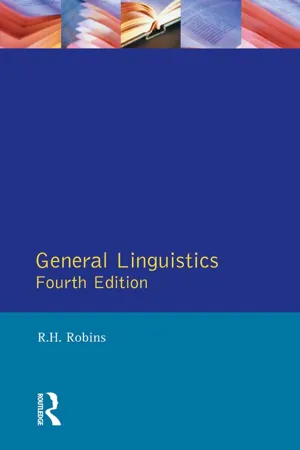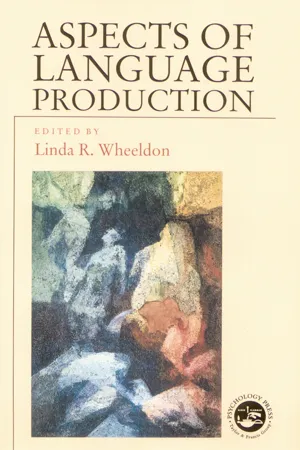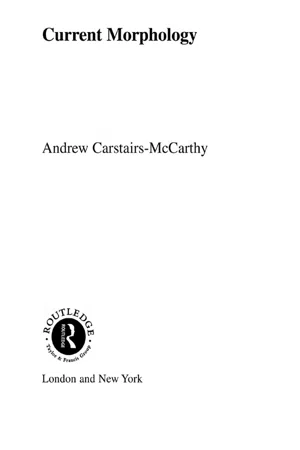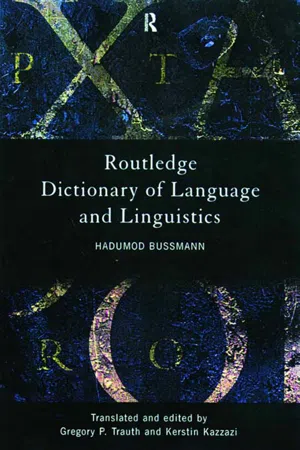Languages & Linguistics
Agglutinating Languages
Agglutinating languages are a type of language where words are formed by combining morphemes, each of which represents a distinct meaning. These morphemes are added to the root word, which remains unchanged. Examples of agglutinating languages include Turkish, Finnish, and Swahili.
Written by Perlego with AI-assistance
Related key terms
Related key terms
1 of 4
Related key terms
1 of 3
5 Key excerpts on "Agglutinating Languages"
- eBook - ePub
- R.H. Robins(Author)
- 2014(Publication Date)
- Routledge(Publisher)
Morphologically complex words, in which individual grammatical categories may be fairly easily assigned to morphemes strung together serially in the structure of the word, exemplify the process of agglutination; illegalities /i-liːˈg-æ-iti-z/, ungodlines /ʌn-ˈgɔd-li-nis/, unavoidably /ʌn-əˈvɔid-əbl-i/, and stabilizers /ˈsteibil-aiz-ə-z/, are examples from English of agglutinative word structures. Words in which several grammatical categories are marked by word forms in which it is difficult, if not impossible, to assign each category to a specific and serially identifiable morphemic section are instances of fusional word structure (the term inflecting, or inflectional, is the older and traditional name for the typological class here called fusional; but this latter term is preferable in view of the quite separate use of inflection as the designation of a type of morphological formation, 6.4.5). English noun plurals like men, mice, geese, and women are inflectional in structure as against the grammatically equivalent agglutinative forms like cars, houses, and cats. It may be noticed that the specifically inflectional structures of English words are in the minority subclasses and irregular forms of the word classes concerned. Regular morphological structures in English are usually agglutinative. While pure exemplars of any of the three types of word form structure throughout a language are very rare among the languages of the world, some languages make use of one type of word formation to a predominant extent, and are consequently classified as isolating, agglutinative, or fusional languages. Chinese and several of the languages of South-east Asia, Vietnamese being perhaps the purest example of the type, are classified as isolating. In them bound morphemes are rare, and words containing more than a single morpheme are not thereby grammatically different in other respects from monomorphemic words - eBook - ePub
- Linda Wheeldon(Author)
- 2013(Publication Date)
- Psychology Press(Publisher)
köy, “village” can have a suffix attached to it, as in (2b, and 2c), or it can be the root portion of a stem, to which further affixes are added, as in (2d, and 2e):As expected in an agglutinative system, each suffix in the Turkish example bears a unique meaning: –e is the dative suffix, –den is the ablative suffix, –jik means “little”, –ler is the plural suffix, –imiz means “our”, and –de means “in”. Each of these suffixes is fully productive, and each is clearly identifiable in the morpheme string.Multiply affixed words like those in (2) raise the issue of morphological structure of the lexical entry. Are polymorphemic words listed as whole-word forms in the mental lexicon (e.g., Butterworth, 1983; Lukatela, Gligorijevic, Kostic, & Turvey, 1980; Segui & Zubizaretta, 1985; Stemberger, 1985), are all morphemes listed individually (e.g., Dell, 1986; Taft & Forster, 1975), or are both whole-word and individual morphemes available (e.g., Frauenfelder & Schreuder, 1992)? If words are listed as wholes, is the morphological constituency of a word like köyjiklerimizde available (in actual structure or via connections, depending on the framework), or are the morphological boundaries unavailable in the mental lexicon?Hankamer (1989) argues convincingly that agglutinative languages could not be accounted for using a mental lexicon that lists each word as a whole form (with or without internal structure). In Turkish, over 200 billion entries would need to be stored, and there is not enough storage capacity in a human brain for such a large lexicon. (Though Hankamer’s argument is directed towards lexical parsing, it holds equally well for production.) A production model that is able to account for words used in agglutinative languages such as Turkish, then, must have a morpheme storage and access system that is able to build words from their constituent morphemes, rather than one that can only access stored whole-word forms. Thus, the presence of agglutinative morphological systems in human languages argues against full-word listing models, and narrows the field of possibilities for lexical representation to either morphological decomposition models or dual-mechanism models, in which both morpheme listing and whole-word listing are available. - eBook - ePub
- Andrew Carstairs-McCarthy(Author)
- 2002(Publication Date)
- Routledge(Publisher)
7The attempts that we have described so far to explain grammatical change through morphological typology have been relatively clumsy; our criticisms may not necessarily apply to a more subtle approach. In von der Gabelentz’s spiral model, an agglutinative language may display (morpho) phonological alternations in stems triggered by neighbouring inflectional affixes, and these alternations may acquire the status of fused inflections if subsequent phonological changes destroy the affixes in question, as in the development from Proto- Lappish to modern Lappish illustrated at (9); but these latter changes are independent of the earlier stem innovations. Is there any reason to claim that the two phenomena are not independent after all? If there is, then typology may actually help to explain, not merely describe. Korhonen (1969:303–42) answers yes to this question, invoking information theory in an ingenious fashion. First, he discusses measurements of the relative levels of redundancy and ‘entropy’ (roughly, unpredictability) in texts in a variety of languages, tending to show that the balance between redundancy and entropy is about constant; roughly, there has to be a certain amount of redundancy in the linguistic signal, but neither too much nor too little. He then points out that stem alternations of the kind just referred to tend to increase redundancy, to the extent that they and the affixes which trigger them are mutually predictable. If this increase is small, nothing need happen. But Korhonen calculates that the stem changes which took place in Proto-Lappish increased redundancy to such an extent that the proper balance between redundancy and entropy was thrown awry. To restore the balance, the language had no choice but to either abandon the new stem alternations (as happened in southern Lappish dialects) or else blur the distinctness of the affixes so as to increase the entropy of the stem alternations (as happened in all other Lappish dialects). - eBook - ePub
- Hadumod Bussmann, Kerstin Kazzazi, Gregory Trauth, Kerstin Kazzazi, Gregory Trauth(Authors)
- 2006(Publication Date)
- Routledge(Publisher)
isolating language), such as Classical Chinese, the grammatical relations between words in a sentence are expressed by independent syntactic form elements (e.g. prepositions), while in synthetic languages they are expressed by dependent morphological units (see Schlegel 1818). In the synthetic languages, Schlegel distinguishes between Agglutinating Languages, in which grammatical and lexical morphemes with simple semantic components are simply affixed to each other (e.g. Turkish), and inflectional languages, whose words cannot be analyzed into single morphemes with simple semantic meaning and which sometimes demonstrate phenomena such as root or stem alternation (e.g. Sanskrit). Humboldt (1836) added the term ‘polysynthetic languages,’ (⇒ polysynthesis) in which a word often combines several word stems with very specific semantic meaning (e.g. Iroquoian) (also ⇒ incorporating language). In this early stage of language typology, value judgments were also attached to each type: the richness of forms in the inflectional languages was considered a sign of greater development, while the isolating and Agglutinating Languages were seen as less developed stages on their way to becoming inflectional languages. For a history of the research on language typology, see Haarman (1976). The main objections against this traditional, primarily morphological, typology are based on the lack of theoretical agreement about the nature of the elements (such as syllable, morpheme, word) and properties (such as intonation, concatenation - eBook - ePub
Applying Linguistics in the Classroom
A Sociocultural Approach
- Aria Razfar, Joseph C. Rumenapp(Authors)
- 2013(Publication Date)
- Routledge(Publisher)
Think of the word “cat.” When we teach our students to make this word plural we tell them the English rule is to add an “-s” to make “cats.” This basic rule is an example of how English combines two morphemes into one word. The first morpheme is “cat” which we, in English, identify as a noun. The second is the plural marker, which we can add to most nouns to make plural. This constitutes a morphological rule. As we have said previously, linguistic rules are different from prescriptive rules found in school-based grammar books. For linguists, it is a rule because we can use it to describe how a language works, even though the rule is not always true. We could call English, then, a fusional language in that many words can be made up of multiple morphemes, or they are “fused” together. Not all languages have a morphological structure like English. In some languages, like Mandarin, almost every word is only a single morpheme. We might call a language like this isolating. In English we would change the word to show past tense, but in Mandarin the word doesn’t change at all. Another word is simply added to the sentence. The morphological rules in isolating languages are quite simple compared to English because tense, case, aspect, number, and other grammatical concepts are understood in the context of the sentence or conversation, and not in the word itself. Another category of languages may be called agglutinating or polysynthetic. Similarly to fusional languages, Agglutinating Languages combine different morphemes to form what we would call a word. However, these words sometimes may contain so much information that it would be similar to an entire sentence in English. Many Native American languages are polysynthetic, including Inuit languages. For example, in one Inuit language, “katimaqatigijunnaqinnga?” roughly translates to “Can I meet with you?” (Pirurvik Centre, 2012)
Index pages curate the most relevant extracts from our library of academic textbooks. They’ve been created using an in-house natural language model (NLM), each adding context and meaning to key research topics.
Explore more topic indexes
Explore more topic indexes
1 of 6
Explore more topic indexes
1 of 4




